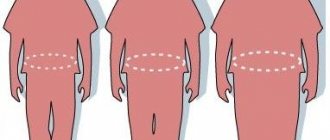Any person who dreams of having a slim figure and maintaining a normal weight should know how many calories he needs per day. Each has its own individual parameters. To calculate your calorie intake, you should use the Harris-Benedict formula.
They first heard about her in 1919. The formula determines the basic metabolic rate, which combines the amount of energy required for any physical activity.
Your calorie intake according to the Harris-Benedict formula:
Daily calorie intake (basal metabolic rate):
Basal metabolic rate taking into account activity:
Why you need to count calories
Calorie calculation is based on the law of conservation of energy - one of the most important, fundamental laws of nature. It always works, which is why it is an important component of the most effective weight loss methods. Knowledge and understanding of this issue will help you effectively and successfully solve important problems related to weight loss and achieve your desired results.
From a biological point of view, one calorie is the required amount of energy that is expended to heat one gram of water by one degree Celsius under normal atmospheric conditions. This value is extremely small, so calorie intake per day is calculated in a larger value - kilocalorie.
Not every person thinks about how much energy the body spends to perform daily tasks. Scientists have found that on average the female body spends about one and a half thousand kilocalories to maintain vital functions. Due to this, breathing, heart rate, muscle tone, peristalsis, constant body temperature, and other processes occurring in the body are ensured. For men, this value is slightly larger, amounting to 1800 calories. This value has a special name - basal or basic metabolism. To determine it, special formulas or special devices are used - a body composition analyzer and a metabolograph.
The component is the main one, but in addition to it there are other energy costs. Physical activity also involves burning calories. A leisurely walk consumes about 150 kilocalories per hour, while intense sports can burn much more - up to 400-500. The calories consumed daily are used to support human life. All the energy that is not consumed by the body is stored. That is why for effective, noticeable weight loss it is necessary to create a daily energy deficit, the size of which should be about 500-700 calories. To get the desired effect, you can count calories yourself or use a ready-made menu.
Expert opinion
Considering that the basis for calorie counting is the law of conservation of energy - as fundamental a law of nature as, for example, gravity - we can say that calories are outdated or inconvenient, just like gravity. Try throwing a pen or pencil above you - and everything will become clear. The laws of nature always work. They are the basis of all effective weight loss methods. Knowledge and understanding of these rules helps you to be effective and successfully solve important problems, as well as issues related to weight loss. So what are calories?
1 calorie is the amount of energy required to heat 1 gram of water by 1 degree Celsius. This is a very small value, so calories are usually measured in thousands - kilocalories, kcal. A woman’s body spends about 1500 kcal daily to maintain vital functions (heart rate, breathing, muscle tone, peristalsis, body temperature and other processes), a man’s body about 1800 kcal. The amount of energy that the body spends to maintain life is called basal metabolism. To more accurately calculate this value, there are special devices - a body composition analyzer and a metabolograph.
This part of energy consumption is the main one, but not the only one. Physical activity also consumes energy, but somewhat less. For example, such active sports as swimming and cycling burn only 150-250 kcal of energy in 60 minutes, it all depends on the intensity of the workout. For noticeable weight loss, it is necessary to create an energy deficit equal to approximately 500-700 kcal from these figures, that is, women need to eat within 1200 kcal daily, men - about 1500 kcal for stable weight loss without harm to the body and all its systems. And then you can go in two ways: directly count calories or introduce indirect calorie restriction through diet and diet selection.
Direct calorie counting requires some skill and perseverance in the early stages, but for many people it works better than any weight loss diet. How to count calories? To do this, you need to know the mass of the product (after weighing it on an electronic food scale), know the calorie content of the product per 100 grams, and also have paper, a pen, a calculator and a few minutes of time on hand.
So, the process of weight loss is a change in the balance between incoming and expended energy. The most direct, simple way, accessible to everyone, is to limit the caloric content of food by counting calories, which, if the proper caloric content is observed, will guarantee the breakdown of fat, according to the law of conservation of energy. However, the direct calorie counting method has its drawbacks. Firstly, it does not report anything about satiety: for example, for the same figure of 1200 kcal daily you can be both very full and very hungry, it all depends on the diet, the included products 1200 kcal - that’s two bars of chocolate or five full-fledged ones meals from permitted, healthy foods. Secondly, with an incorrectly selected diet on a reduced calorie diet, weight will decrease, but this may be associated with health risks - for example, not only fat, but also muscle tissue may be lost if there is a deficiency of protein in the diet. And thirdly, you won’t count calories for the rest of your life; after losing weight, you need to develop other mechanisms and habits to maintain it. These and other reasons make caloric intake a necessary, but not the only tool in the weight loss process.
Consequences of incorrect calculation of BZHU
Diet compilers most often neglect calculating BJU and take into account only the number of calories. As a result, the balance of substances in the human body is disrupted, which leads to:
- Constant hunger. A person has just eaten and is already dreaming about the next meal. This clearly indicates a lack of fats and carbohydrates.
- Slow weight loss. The body receives too few nutrients, so it adapts to save resources, so that fat is burned slowly.
- Constant volume. Weight decreases due to the removal of fluid from the body and a reduction in muscle mass. But the fat layers remain in place, so there are no visual changes.
- Disturbances in the functioning of hormones. This leads to mood swings, decreased performance, and sore skin, hair and nails.
- Health problems. Nausea, dizziness, tinnitus and even fainting - all this signals an unbalanced diet.
Thus, calculating BJU is an important procedure not only for losing weight or gaining muscle mass, but also for maintaining good physical shape and improving the health of the body. Nutrition in accordance with the calculations provides all the substances necessary for the body, which entails a lot of positive consequences.
Formulas for counting calories
You can calculate your daily calorie intake for weight loss using the following two formulas.
The Harris-Benedict formula was developed and introduced to people in 1919 by famous scientists Francis Gano Benedict and James Arthur Harris. It has two varieties: for men and for women.
66 + [13.7 x weight (kg)] + [5 x height (cm)] - [6.76 x age (in years)] - for men;
655 + [9.6 x weight (kg)] + [1.8 x height (cm)] - [4.7 x age (in years)] - for women.
This calculation formula may be incorrect for modern residents of the metropolis, since the research was carried out at the beginning of the last century. This nuance should be taken into account when calculating the number of calories, especially for people whose body mass index exceeds the established norm.
The Mifflin-San Geor formula was developed much later - at the end of the last century, in the nineties. It is considered the most accurate and popular today.
Men - [9.99 x weight (kg)] + [6.25 x height (cm)] - [4.92 x age (years)] + 5;
Women - [9.99 x weight (kg)] + [6.25 x height (cm)] - [4.92 x age (years)] -161.
The formula takes into account the specifics of nutrition and other features of the modern world. However, it does not take into account the percentage of fat and muscle tissue.
Calorie counting algorithm for weight loss
The ability to correctly count calories consumed is the first step towards a healthy, beautiful body. This technique does not impose any restrictions on specific products. But, if you take into account your entire diet every day, it becomes clear that it is much better to eat a plate of meat salad than a small chocolate bar or some kind of confectionery product. Their calorie content is approximately the same, but their nutritional value is significantly different.
Calculating calorie intake is considered an effective way to lose weight and is included in many weight loss systems. This is explained by the following advantages:
- This method provides a reasonable approach to nutrition, without stress or serious restrictions. The body easily tolerates a new diet;
- the ability to calculate the number of calories consumed allows you to choose a complete diet rich in nutritional components, vitamins, minerals, which distinguishes this technique from various types of diets and fasting;
- Each person can independently determine how many calories they need to consume per day. For this purpose, there are special calorie calculator for weight loss online. This may be useful for those people who do not have the opportunity to contact competent specialists or a weight loss clinic due to the remoteness of settlements from urban centers, various material restrictions, and life circumstances;
- The calorie counter will allow you to calculate your diet for free, include your favorite dishes, and ensure compliance with the proportions of proteins, fats, and carbohydrates.
The calculation algorithm consists of three successive steps: calculating the basic metabolic rate, determining daily activity, calculating the final result. Let's take a closer look at each of them.
Step 1: Calculate your basal metabolic rate
To begin with, one of the most convenient formulas should be used to calculate the basic metabolic rate. Example: a woman 170 cm tall, weighing 75 kg, aged 36 years should consume no less than:
655+9.6×75+1.8×170-4.7×36=1512 kcal
This amount of energy will be enough to support life.
Step 2: Determine your daily activity
The resulting value of basal metabolism must be multiplied by the activity coefficient:
- 1.2 – low activity, complete absence of sports;
- 1.375 – sedentary lifestyle, light physical activity 1-2 times a week;
- 1.55 – average activity, sufficient load 2-4 times a week;
- 1.725 – active lifestyle, active work, training about 5 times a week;
- 1.9 – high activity, active work, daily active training.
Let's say a woman goes to fitness three times a week, then:
1512 kcal × 1.55 = 2344 kcal
This value is the required daily norm. This is how many calories you need to consume per day.
Step 3: Calculate the final result
To obtain the final result, you need to subtract 500-700 kcal from the resulting value - this is exactly how much you need to consume per day to lose weight.
2344 – 500(700) = 1844 (1644) kcal – this is exactly how much the body needs to start losing weight.
Practice shows that it is difficult to maintain the norm daily. Nutritionists suggest setting a minimum lower and maximum upper limit. This will help avoid breakdowns: if you really want something forbidden, you can eat it. But the next day, reduce the norm a little:
- upper limit: calorie norm + 100;
- lower limit: calorie norm – 200.
In addition, it is recommended to maintain the ratio of proteins, fats, carbohydrates:
- protein 10-25% of the daily diet;
- fats – 20-35%;
- carbohydrates – 45-65%.
These ratios may vary slightly depending on the specific goal: weight loss, weight gain, muscle growth.
Losing weight quickly and effectively at home is not difficult. Counting calories reduces restrictions and allows you to enter your favorite foods. The main thing is to conscientiously keep a diary, write down every product consumed, every sugar cube. But there is a special technique for weight loss, which is offered in weight loss clinics. It is based on an integrated approach, a combination of nutrition and psychology. This allows you to achieve optimal results and effective weight loss.
Calculation of total metabolism
Total or basal metabolic rate (BMR) is the optimal number of calories needed to maintain basic body functions. These functions include digestion, maintaining temperature, growth, and so on. According to research, basal metabolism takes up about 75% of the total kcal. The Harris-Benedict formula helps determine the required parameters.
The process of determining BMR uses the Harris-Benedict formula to calculate calories. A person’s height, age, weight and lifestyle are taken into account. The activity coefficient determines the total energy consumption of the body and is one of the main parameters for determining BMR using the Harris-Benedict formula.
Calorie tables
The table of caloric content of foods will help in preparing your daily diet. It contains basic products, which, as a rule, are the basis of the diet. For all other products purchased in stores, the calorie content, protein, fat and carbohydrate content are indicated on the packaging.
Milk products
| Product (per 100 g of product) | Proteins (g) | Fat (g) | Carbohydrates (g) | Energy value (kcal) |
| Dry cream | 23,0 | 42,7 | 26,3 | 579,0 |
| Whole milk powder | 26,0 | 25,0 | 37,5 | 476,0 |
| Skimmed milk powder | 37,9 | 1,0 | 49,3 | 350,0 |
| Condensed milk with sugar | 7,2 | 8,5 | 56,0 | 320,0 |
| Cow's milk | 3,2 | 3,6 | 5,1 | 61,0 |
| Sour cream, 30% fat | 2,4 | 30, | 3,1 | 294,0 |
| Fat cottage cheese | 14,0 | 18, | 2,8 | 232,0 |
| Cream, 20% fat | 2,8 | 20,0 | 4,5 | 206,0 |
| Cream, 10% fat | 2,8 | 10,0 | 4,8 | 118,0 |
| Full fat kefir | 2,8 | 3,0 | 3,6 | 56,0 |
| Cheese "Russian" | 23,0 | 29,0 | 0,0 | 360,0 |
| Cheese "Dutch" | 26,0 | 26,8 | 0,0 | 352,0 |
| Cheese "Poshekhonsky" | 26,0 | 26,5 | 0,0 | 350,0 |
| Processed cheese | 22,0 | 27,0 | 0,0 | 340,0 |
| Brynza | 17,9 | 20,1 | 0,0 | 260,0 |
| Unsalted butter | 0,5 | 82,5 | 0,8 | 748,0 |
| Ice cream | 3,3 | 10,0 | 20,1 | 179,0 |
| Milk margarine | 0,3 | 82,0 | 1,0 | 743,0 |
| Mayonnaise "Provencal" | 2,8 | 70,0 | 2,6 | 624,0 |
Bread and cereals
| Product (per 100 g of product) | Proteins (g) | Fat (g) | Carbohydrates (g) | Energy value (kcal) |
| Wheat flour, whole grain | 10,3 | 1,0 | 69,0 | 334,0 |
| Millet groats | 11,5 | 3,3 | 67,2 | 348,0 |
| Buckwheat | 12,6 | 3,2 | 54,3 | 335,0 |
| Rice groats | 7,0 | 1,0 | 73,2 | 330,0 |
| Semolina | 10,3 | 1,0 | 67,7 | 328,0 |
| Barley groats | 10,00 | 1,30 | 66,31 | 324,00 |
| Pearl barley | 9,3 | 1,1 | 67,5 | 320,0 |
| Groats "Hercules" | 11,0 | 6,2 | 49,2 | 305,0 |
| Oatmeal | 11,0 | 6,1 | 49,9 | 303,0 |
| Wheat bread, whole grain | 7,9 | 0,8 | 50,1 | 238,0 |
| Rye bread | 6,6 | 1,2 | 41,8 | 181,0 |
| Sugar cookies | 7,5 | 11,8 | 74,4 | 436,0 |
| Cream crackers | 8,5 | 10,8 | 69,6 | 398,0 |
| Pasta, V.S. | 10,4 | 1,1 | 74,9 | 337,0 |
| Butter bun | 7,6 | 5,2 | 56,8 | 295,0 |
| loaf | 7,7 | 3,0 | 53,3 | 235,0 |
| Yeast | 12,7 | 2,7 | 0,0 | 75,3 |
Vegetables and fruits
| Product (per 100 g of product) | Proteins (g) | Fat (g) | Carbohydrates (g) | Energy value (kcal) |
| Green peas | 5,0 | 0,2 | 13,8 | 73,0 |
| Ground tomatoes | 1,1 | 0,2 | 5,0 | 23,0 |
| Potato | 2,0 | 0,4 | 18,1 | 80,0 |
| Eggplant | 1,2 | 0,1 | 6,9 | 24,0 |
| White cabbage | 1,8 | 0,2 | 6,8 | 27,0 |
| Sauerkraut | 1,8 | 0,0 | 3,2 | 19,0 |
| Bulb onions | 1,4 | 0,0 | 10,4 | 41,0 |
| Green onion | 1,3 | 0,0 | 5,2 | 19,0 |
| Garlic | 6,5 | 0,0 | 6,0 | 46,0 |
| Carrot | 1,3 | 0,1 | 7,9 | 30,0 |
| cucumbers | 0,8 | 0,1 | 3,8 | 14,0 |
| Pickles | 0,8 | 0,1 | 2,3 | 13,0 |
| Pepper | 1,3 | 0,0 | 7,2 | 27,0 |
| Radish | 1,9 | 0,2 | 8,0 | 35,0 |
| Turnip | 1,3 | 0,0 | 3,1 | 27,0 |
| Radish | 1,2 | 0,1 | 3,8 | 21,0 |
| Salad | 1,5 | 0,2 | 3,1 | 17,0 |
| Beet | 1,5 | 0,1 | 12,8 | 42,0 |
| Pumpkin | 1,0 | 0,1 | 5,9 | 25,0 |
| Spinach | 2,9 | 0,3 | 2,5 | 22,0 |
| Pears | 0,4 | 0,3 | 10,9 | 49,0 |
| Apples | 0,4 | 0,4 | 11,8 | 45,0 |
| Peaches | 0,3 | 0,1 | 11,3 | 43,0 |
| Apricots | 0,9 | 0,1 | 10,8 | 41,0 |
| Oranges | 0,9 | 0,2 | 10,3 | 40,0 |
| Watermelon | 0,7 | 0,2 | 7,9 | 38,0 |
| Melon | 0,6 | 0,0 | 10,3 | 38,0 |
| Grapefruits | 0,9 | 0,2 | 10,3 | 35,0 |
| Strawberries | 0,8 | 0,4 | 11,2 | 34,0 |
Dried fruits and beans
| Product (per 100 g of product) | Proteins (g) | Fat (g) | Carbohydrates (g) | Energy value (kcal) |
| Dried apricots | 3,3 | 62,6 | 30,8 | 241,0 |
| Raisin | 2,5 | 78,4 | 16,5 | 296,0 |
| Dates | 2,4 | 75,0 | 20,5 | 282,0 |
| Prunes | 2,3 | 65,6 | 25,0 | 264,0 |
| Figs | 3,3 | 63,8 | 30,0 | 249,0 |
| Dried apples | 3,2 | 68,0 | 20,0 | 273,0 |
| Dried pears | 2,3 | 62,6 | 20,0 | 249,0 |
| Dried peaches | 3,0 | 68,5 | 18,0 | 274,0 |
| Peas | 54,8 | 0,1 | 8,5 | 298,0 |
| Chickpeas | 54,2 | 20,1 | 5,0 | 328,6 |
| Soybeans | 34,9 | 17,3 | 17,3 | 364,0 |
| Beans | 21,0 | 2,0 | 47,0 | 298,0 |
Meat
| Product (per 100 g of product) | Proteins (g) | Fat (g) | Carbohydrates (g) | Energy value (kcal) |
| Pork | 11,7 | 33,3 | 0,0 | 491,0 |
| Beef | 18,5 | 16,0 | 0,0 | 218,0 |
| Mutton | 15,6 | 16,3 | 0,0 | 209,0 |
| Rabbit meat | 21,1 | 15,0 | 0,0 | 183,0 |
| Beef liver | 17,9 | 3,7 | 0,0 | 105,0 |
| Beef heart | 16,0 | 2,8 | 0,0 | 86,0 |
| Pork stew | 14,9 | 32,2 | 0,0 | 349,0 |
| Beef stew | 16,8 | 16,0 | 0,0 | 220,0 |
| Chickens | 18,2 | 18,4 | 0,7 | 241,0 |
Sausages
| Product (per 100 g of product) | Proteins (g) | Fat (g) | Carbohydrates (g) | Energy value (kcal) |
| Amateur sausage | 17,3 | 39,0 | 0,0 | 420,0 |
| Semi-smoked sausage | 16,5 | 63,6 | 0,0 | 376,0 |
| Milk sausages | 11,0 | 22,8 | 1,6 | 266,0 |
| Doctor's sausage | 12,8 | 22,2 | 1,5 | 257,0 |
| Sausage var. separate | 11,0 | 21,0 | 0,0 | 240,0 |
Eggs
| Product (per 100 g of product) | Proteins (g) | Fat (g) | Carbohydrates (g) | Energy value (kcal) |
| Raw chicken egg | 12,7 | 11,5 | 0,7 | 157,0 |
| Melange | 12,9 | 11,6 | 0,8 | 160,0 |
| Egg white | 10,5 | 0,0 | 1,0 | 50,0 |
| Egg yolk | 16,7 | 30,8 | 1,7 | 358,0 |
Fish and seafood
| Product (per 100 g of product) | Proteins (g) | Fat (g) | Carbohydrates (g) | Energy value (kcal) |
| Cod liver (canned in oil) | 4,20 | 65,70 | 1,20 | 613,0 |
| Salmon | 23,0 | 12,0 | 0,0 | 206,0 |
| Shrimps | 18,9 | 2,2 | 0,0 | 95,0 |
| Pollock | 17,6 | 1,0 | 0,0 | 79,0 |
| Perch | 19,9 | 3,6 | 0,0 | 112,0 |
| Salmon | 20,0 | 8,3 | 0,0 | 153,0 |
| Tuna | 26,0 | 1,0 | 0,0 | 115,0 |
| Cod (liver) | 16,0 | 0,6 | 0,0 | 136,0 |
| Horse mackerel | 18,5 | 4,5 | 0,0 | 114,0 |
| Squid | 18,0 | 4,2 | 0,0 | 110,0 |
| Sardines in oil (canned) | 16,0 | 17,7 | 0,0 | 223,0 |
| Mackerel Blancheer. In oil | 13,1 | 25,1 | 0,0 | 278,0 |
| Flounder in tomato (canned) | 12,6 | 5,4 | 6,0 | 125,0 |
Sweets
| Product (per 100 g of product) | Proteins (g) | Fat (g) | Carbohydrates (g) | Energy value (kcal) |
| Jam | 0,4 | 0,2 | 74,5 | 286,0 |
| Waffles | 8,2 | 19,8 | 53,1 | 425,0 |
| Hematogen | 6,2 | 2,8 | 75,5 | 352,0 |
| Marshmallow | 0,7 | 0 | 75,5 | 295,0 |
| Iris | 3,1 | 7,7 | 81,2 | 384,0 |
| Marmalade | 0,0 | 0,2 | 77,1 | 289,0 |
| Honey | 0,6 | 0,0 | 80,5 | 312,0 |
| Sugar | 0,2 | 0,0 | 99,6 | 377,0 |











